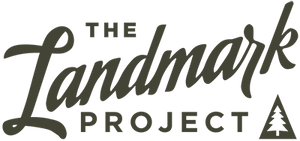Landmark Presents - First Aid Tips for Your Next Adventure
When it comes to hiking and camping, planning for a life-threatening emergency can feel unnecessary— especially if you’ve gone dozens of times without any problems. But knowing basic first-aid and packing some essentials can make all the difference between a small injury and an all-out emergency.
Over the years, we’ve come to rely on some first-aid essentials, pocket guides, and classes. We’re sharing our favorites in hopes they help you stay safe out in America’s wild places! (None of these are affiliate links– just our top recommendations for your next excursion.)
First Aid Kit Essentials
You likely remember to bring bandages and a water bottle before heading out on a hike. What you might not consider bringing are items essential for wilderness survival. If you’re ever stranded during a hike or camping trip, you’ll want some basics to stay safe and warm.
That’s why we recommend adding a couple of wilderness-specific items to your basic first-aid kit. We recommend including:
- Water purifying tablets or filter
- Tweezers and a sharp pocket knife
- Athletic tape roll for blister prevention
- NSAIDs such as ibuprofen to treat pain and inflation
- Anti-diarrheal to prevent dehydration
- Two ways to start a fire (a lighter as well as a Ferro rod with a length of jute)
- A QuikClot pad for more serious injuries
- Bandanas for wound dressing and sun protection
- Extra toilet paper (because you just never know!)
That list may sound long, but it won’t fill more than a quart-size bag and can make all the difference in a crisis.
We also really like the American Hiking Society’s Ten Essentials. Whether you’re new to hiking or an avid backpacker, their list of hiking essentials and tips for packing a personalized first-aid kit are indispensable. Even the most experienced hikers run into snags or forget to pack an essential. That’s why we love a good list and AHS’s tips!
First Aid Pocket Guides
Another great item to stow in your day pack is a first-aid pocket guide. Our favorite basic pocket guide is from the Red Cross. Their easy-to-follow Emergency First Aid Guide includes diagrams and numbered steps. We recommend reading it through before your next trip. But even if you don’t, this guide is a fast reference when cell service isn’t available and first responders can’t arrive right away. Plus, it costs less than five dollars and is lightweight enough for even the most serious backpacker.
We also love the Red Cross’ Wilderness and Remote First Aid Emergency Reference and Pocket Guide. This in-depth guide details what to do in backcountry-specific emergencies. This is the official Red Cross Wilderness First Aid Course guide completed by most backcountry guides and first responders. The class is a good investment if you want to get off the beaten path, camp, and hike in remote areas. But even without the class, the pocket guide is easy to read and another life-saving part of your camping first-aid kit!
Another great pocket guide is Dave Canterbury’s Wilderness First Aid. As a survival expert and master woodsman, Dave Canterbury’s foldable and waterproof guide includes common sense tips that save lives in the backcountry. Plus, it costs less than a water bottle and most coffees so it’s definitely worth the investment.
We suggest snapping a few photos of your pocket guide to keep locally on your phone in case you forget or misplace your guide before a big excursion.


First Aid Classes
Of course, there’s no replacement for knowing first aid off the top of your head. Getting first-aid certified is easy, fast, and often free. Many local fire departments and libraries host free first-aid classes throughout the year. We recommend reaching out to your local fire department or library to ask about classes in your area.
If you want to take a class immediately, you can search for a local class on the Red Cross website or sign up for an online class. These classes are very affordable and worth it for peace of mind.
If you’re headed on a hike and want to review first aid for specific wilderness scenarios, we love the NOLS YouTube channel. NOLS is a nonprofit global wilderness school and leader in outdoor education. Their videos cover everything from managing an ankle sprain out on the trail to assessing an injured spine after a significant fall.
While we don’t recommend medical interventions out on the trail without proper training, knowing when something is a simple sprain or a more serious injury that requires emergency medical attention is helpful.
Don’t go wild in wild places
Of course, the best way to stay safe on your next adventure is to treat the wild with the respect it deserves. Don’t approach wild animals or take selfies too close to the ridge. Most serious injuries are preventable with a little bit of planning and caution.
Are you first aid certified? What are your hiking and camping essentials? Give us a shout and share your recommendations.
In the meantime, stock up on the essentials and stay safe out there!


Leave a comment